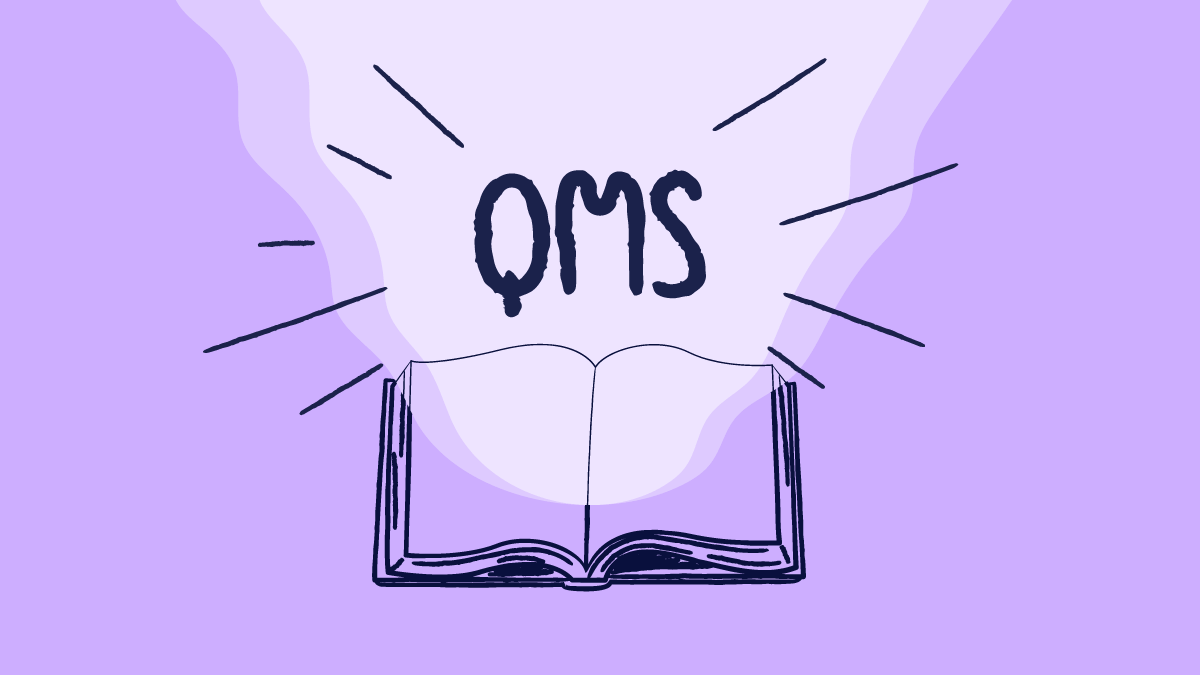
Companies in the life sciences continuously strive to adapt to new developments in our rapidly evolving modern world. Professionals in businesses like pharma, medical devices, and biotech know that in this digital age organizing processes and going paperless with an Electronic Quality Management System (eQMS) is a must to keep up, let alone get ahead.
If you work in the pharmaceutical industry and want to explore the specific benefits of an eQMS for your sector, be sure to check out our QMS in pharma guide.
QMS to eQMS: The (r)evolution from Paper to Digital
The evolution of Quality Management Systems (QMS) has come a long way. Before we had manual paper-based systems, we now have fully digital, hyper-efficient cloud-based platforms.
With old paper-based QMS, continuous improvement was a strenuous journey. Adjusting to even small changes required the kind of time investment that would be unthinkable nowadays. Moreover, a paper-based QMS in most growing companies would inevitably turn into wildly chaotic document storage. As companies expanded in the past, so would their stacks of paper and process documentation. Keeping each individual document up to date quickly turned into a monumental task, and more often than not these paper-based QMS morphed into a black hole where documents were never to be found again. Such a system is not optimized to manage quality efficiently within an organization!
Read: Change management: 7 Steps To A Streamlined Transition
Today’s leading QMS are digital. The eQMS becomes an asset to a business, not a burden. Choosing the right eQMS for your organization will dramatically affect your profit margins, business growth, and resource allocation.
Benefits of an eQMS
There are many advantages to a purely digital eQMS over a paper-based QMS: Beyond the physical storage requirements and organizational issues that paper creates, a digital system offers all of the following benefits and many more:
1. All in One Place
A good eQMS provides a bird's eye view of all processes, services, and products delivered - usually from a central dashboard - in a way that a paper-based QMS never can.
2. Support Change Management
Finding outdated documents is no longer an issue with an eQMS. You can make changes and sync to other processes in real time.
3. Track Progress
Different types of data can be extracted from processes in an eQMS, making progress analysis for KPIs a breeze. In addition, tracking progress leads to more precise decision-making at the company scale.
4. Enable and Analyze Improvement
You can’t improve without knowing your metrics first. Otherwise, how would you measure if you’re actually improving? Data from an eQMS is invaluable, not just for enabling improvement but for monitoring it, too.
5. Easy Audit
If the company’s processes are accessible in the cloud from anywhere and have built-in features such as automatic action logs and quickly searchable documents, the audits will be conducted much faster and will be more accessible for everyone involved. Additionally, an eQMS can provide you with a clear audit trail according to 21 CFR Part 11 with full transparency and traceability, at all times. Audits can be conducted on-site or even remotely, since organizations may face different types of audits, such as internal, external, and supplier audits.
6. Efficient Communication
Not only does a centralized knowledge base help each department complete its tasks more efficiently and autonomously, but it also drastically improves inter-departmental communication. For example, emails back and forth with attached scans of documents are about to be a thing of the past!
7. Hello Automation
This is simply impossible for manual systems like a paper-based QMS. Whenever you need to make a change with a paper QMS, you need to take several manual actions across multiple subprocesses. To manage a change in an eQMS, you fully automate the process at the beginning, and then sit back and relax as it completes the same steps for you.
8. Streamlined Workflows
In an eQMS setup, distinct processes are seamlessly connected so that changes in one process sync in real-time with others—for example, CAPAs, Document Control, and Complaint.
9. Recordkeeping
A detailed history of business activities is recorded and stored in one highly secure place with log details.
10. Happier (and More Efficient) Teams
Removing unnecessary frustrations and obstructions from a task pipeline will result in improved efficiency and boost team morale. Sifting through paper for hours just to find essential information is neither fun nor efficient. SOPs and guidelines for tasks are easy to share. Standardized processes get everyone on the same page, fast.
11. Accessible to Everyone
A significant advantage of any cloud-based software is accessibility. Suddenly, many possibilities open up: remote teams, collaboration, and location freedom.
12. Cost-Savings
A paper-based QMS often has enormous upfront costs as well as ongoing physical storage costs. On the other hand, an eQMS run with less direct operating costs requires no physical storage space (you pay for space on off-site server farms) and requires no steep setup fee.
And it’s eco-friendly, using less paper!
13. Better Training
Without paper, training can be done remotely. Plus, training records are much easier to record and track per employee when hosted digitally. When processes are changed, training on these processes can be automatically updated, and the responsible individuals or roles involved are instantly notified of any retraining required. An established detailed training matrix can allow organizations to have the same level of training per role. Additionally, employees can digitally sign the training materials to show they’ve read and understood their training.
14. No More Missing Documents
Papers can get lost. Storing documents in a highly secured cloud is much less risky. Records and action logs are kept automatically by a good eQMS, so that each action can be traced to the responsible party. eQMS also have backups in place. Also, missing documents can lead to an unsatisfactory result or even a finding during formal audits such as FDA inspections, MoH or ISO audits.
Manufacturers are often unaware that a document has been misplaced or lost when it is removed to be reviewed or changed until an FDA auditor requests it. With an eQMS, manufacturers have better visibility into the existence and completeness of QMS documentation - reducing the risk of lost documents.
15. Lower Compliance Risks
Make sure that the software is updated frequently based on the latest regulatory requirements, allowing you to always work in compliance with new ISO 27001, ISO 15189, ISO 17025, GMP, GDP, and GLP regulations.
16. Validation of the Platform
Computerized system validation in pharma and biotech is costly and time-intensive. Ideally, your eQMS platform offers a fully validated QMS, so decide on one with pre-validation. For example, Scilife uses a GAMP5 validation approach for validating the system on the Amazon Web Services (AWS) platform.
17. Document Management
Document version control and update management become a breeze with features like automatic notifications, compliant e-signatures, and controlled printing and reconciliation. In addition, you can create custom pre-defined approval cycles and custom quality management workflows with configurable modules.
The FDA QSRs require that companies establish and maintain document controls that fulfill the requirements of 21 CFR Part 820. As part of the quality system guidelines, all documents need approval signatures and requirements for making sure that the latest versions are accessible wherever they are designated, used, or otherwise needed. The eQMS helps manage document version control to ensure that the most current approved documents are always readily available - for reference or in case of an audit.
18. Digital Signatures
The regulatory authorities require a stringent approval process for documents that appear in the QMS. Typically, the Quality Manager should review and approve various documents within the QMS. An eQMS that is pre-validated according to GAMP5 and 21 CFR part 11 can allow you to track when and where signatures and approvals are required and streamline the process using automation features and electronic signatures.
19. Accelerated Certification of ISO 13485
With a centralized document control, documents can be imported and exported in batches to create and gain approval for necessary documents at once. To effectively maintain an ISO 13485-certified QMS, use a platform that is designed risk-based approach, especially for medical device manufacturers. Our platform incorporates risk assessment, and you can rest assured knowing you have an audit trail at any time.
20. Compatible With Various Browsers
Your IT policy might require you to use a browser. Ask your platform providers whether the platform is compatible with your browser – or with all of them. You can use whichever browser you like with Scilife. Our platform gives users the flexibility to access anything, anywhere, anytime!
21. Integration Made Easy
Integration becomes essential when you have more than one piece of software. Educate yourself on whether your new eQMS will integrate with your existing systems. For example, Scilife seamlessly connects and integrates with most systems used in the life sciences. This includes standard integrations for user management, such as Microsoft Active Directory or AzureAD out of the box. In addition, our platform leverages auto-scaling cloud technology to provide reliable, turbocharged performance. Depending on user demand, it automatically scales in or out, resulting in a snappy application. Once the initial setup is completed with integrations in place and users onboarded, IT can sit back and relax. The responsibility to keep the system up and running is fully covered by our Service Level Agreement. What’s more, we don’t leave you hanging after onboarding - we’re here when you need us, at any stage in your Scilife Journey.
What to look for in an eQMS
The decision is clearly not about whether or not to choose a paper-based QMS or cloud-based eQMS. However, it can be quite overwhelming to make the jump to a cloud-based system – there are just so many options out there!
Start by narrowing down your search to an eQMS that actually specializes in your business. Then, assess pricing plans and important features such as unique user roles, automations, customizability, customer service, and integrations. It’s also fundamentally important, if you’re operating in a heavily regulated industry such as life sciences to make sure your next eQMS is fully compliant with the latest regulations.
If you’re operating within pharma, biotech, or the medical device space, Scilife is likely to be an ideal fit!
Discover how Scilife eQMS can make your digitalization process a breeze.





